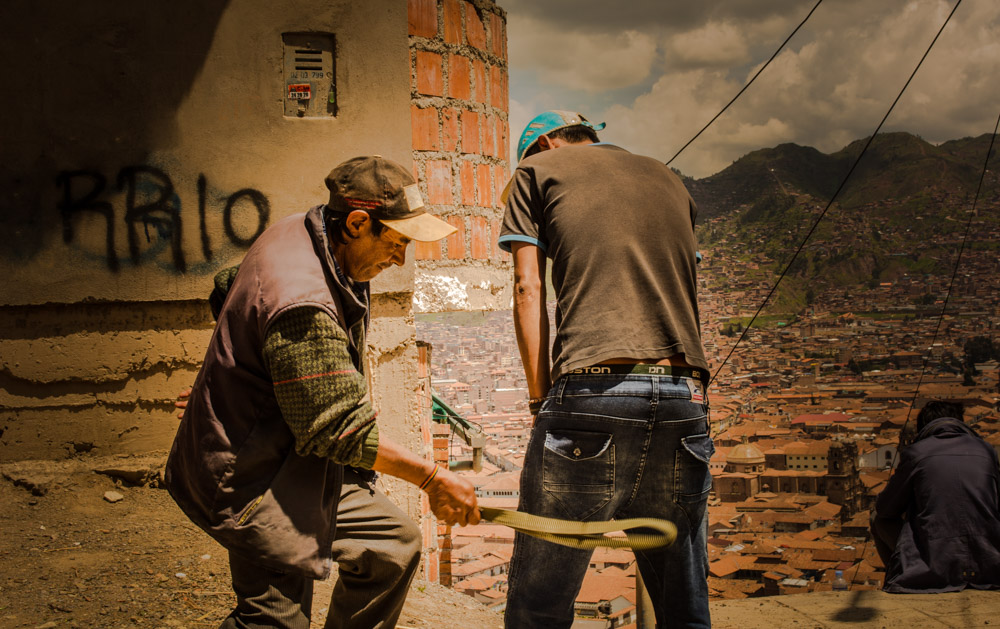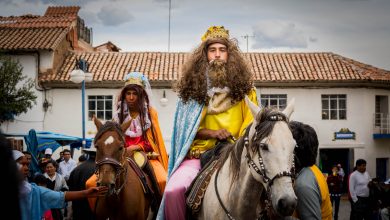People Live their Faith during Holy Week in Cusco

These days people in Cusco are said to “live their faith”. Such a rich phrase, to “live faith”, and yet such a difficult one, these two words split a Protestant world apart from one saturated in a religion without an easy name, the Peruvian historical form of Catholicism.
To Protestant ears, living a faith suggests harmony between actions and the postulates of beliefs, defined by integrity, wholeness, such that they can arguably be seen as one. In contrast, the people of Cusco have a different meaning for the word, one that we can gloss in English as experience. People experience their faith.
Protestants focus much attention on the inner self and here, without slighting inner selves, the focus in Cusco is much more on being present, on having the faith envelop you and even enter you through the ways your body experiences and is disciplined by the faith.
The Ur-story of Christianity, often simply called the “passion of Christ” comes down from the heavens, off the pages, and out of the churches during this Holy Week in Cusco. There are many ways it does so. Let me list a few.

On the Sunday before Easter, Palm Sunday, Domingo de Ramos in Spanish, people obtain tangible tokens of the story of Jesus’ triumphal entry into Jerusalem, the Holy City. Vendors set up early in the morning to sell palm fronds as well as crosses and other beautifully woven and braided artifacts made from palm. People, especially the women, buy these and generally take them to church for them to be blessed by holy water and by the words of blessing given by the priests, if not simply by bringing together holy men, priests, and the holy artifacts.

These, then, are taken into the home, to bring Jesus (and his story) into the intimate place of people’s existence where they see them and notice them every day.
Monday, the local image of Jesus, take center stage. It is much loved by the people of the City and much enlivened by their devotion, much as the palm fronds are given meaning and power by people’s getting them, having them blessed, and taking them home. Now, the social organizations of the city, its government, religious orders, and schools, come together, bring Jesus as the Lord of Temblors, from the Cathedral, and process him on an established route through the city. They always accompany him, dress him, give him flowers and petals, sing to him, and be with him, until it is time for him to go back into Cusco’s main sanctuary. At that time, seemingly everyone converges on the main square to experience the moment and to receive his blessing, his being with them and his dipping and nodding to them in the midst of much sound and deep, intense feeling.
People gather during this weekend with their families, to take advantage of time off from work, declared by the government. They are together now, with their family’s palm crosses and other devotional objects. They watch videos of Christ’s passion and of the Ur times, including classic Hollywood films, at the same time they make they enact a holy dinner.
In honor of the death of Christ, they do not eat meat, and they prepare twelve dishes, six sweet and six savory in a perfectly balanced dualism akin to that of the rainy season when plants flourish and the dry season when they diminish and die, or akin to their families composed of more salty men and sweeter women, or simply death and life.
The savory dishes can be vegetarian or they rely on dairy or seafood. The wet, like the season that is still in course but will soon end, lies at the root of most dishes, although they may fry a fish and serve it with water-boiled rice (another dualism).
When asked, people will say the dishes represent the twelve apostles, and they do in the formal Catholic semiotics of faith. They also mobilize the other dualisms of Cusco’s Andean life, including the wet season that soon will end as plants wither and die, only to come to life again.
Since death stings like salt on a wound, this is also a time of discipline, though that is mostly outside the home. People climb the mountains near Cusco to accompany the various crosses located there. This pilgrimage is already a devotional act and one of disciplining the body through the sensations of feet, legs, and lungs wearying and yet carrying you forward while you risk slipping or stumbling, and falling.
Along the way, many will have themselves whipped by the priests in punishment for their sins, though the word used, sobar, also suggest purification and atonement. They place themselves in an experience that is also represented in a story of a condenado (a person trapped between life and death as they suffer for their sins) who is whipped, as Jesus was also scourged, and then is released from his sinful state and can go on to the afterlife like a dove to heaven.
Their bodies experience the faith and it transforms them. It leads to new life, in the people now relieved of suffering for their sins through the physical act of being whipped, in Jesus being scourged, dying, and then re-living in the resurrection, or in the condenado moving on, finally, to death from which new life can come, like rain from heavens.
The people of Cusco do live their faith, these days. They experience it all around them, on them, and even inside them, especially as they ingest the six sweet and six savory dishes.





For the past seven years, when it comes to holidays, I find myself wishing to be anywhere but here. “Here” really means any place but the one I’m in now: post-religious, post-military, post-marriage. It used to be so easy to believe in something. The psyche aches for ritual and belonging.
I would rather climb a mountain on my knees and be whipped by a priest than wake up tomorrow, just another day, and set out Easter baskets for my kids that have no discernible meaning to them whatsoever. Well, commercial meaning, I suppose, but nothing more. Store-bought trinkets mock my longing. Even homemade ones offer no comfort, for what would they mean? I cannot “live my faith” without faith.
Ironically, between the writing of the above paragraph and this one, the lived faith of others finds its way to my front door in the form of Jehovas Witnesses offering me literature about Christ and Easter. I envy my visitors their clear convictions. For me, I have only questions and blank spaces and memories.
These, and a need to believe in Something. I just don’t know what.
Renee,
Live faith without faith. Yes! I think you are on to one of the problems that afflicts so many people today. In my essay on Cusco I looked mostly at living, and much less at faith. You point to a hole and something I must reflect about. Thank you.